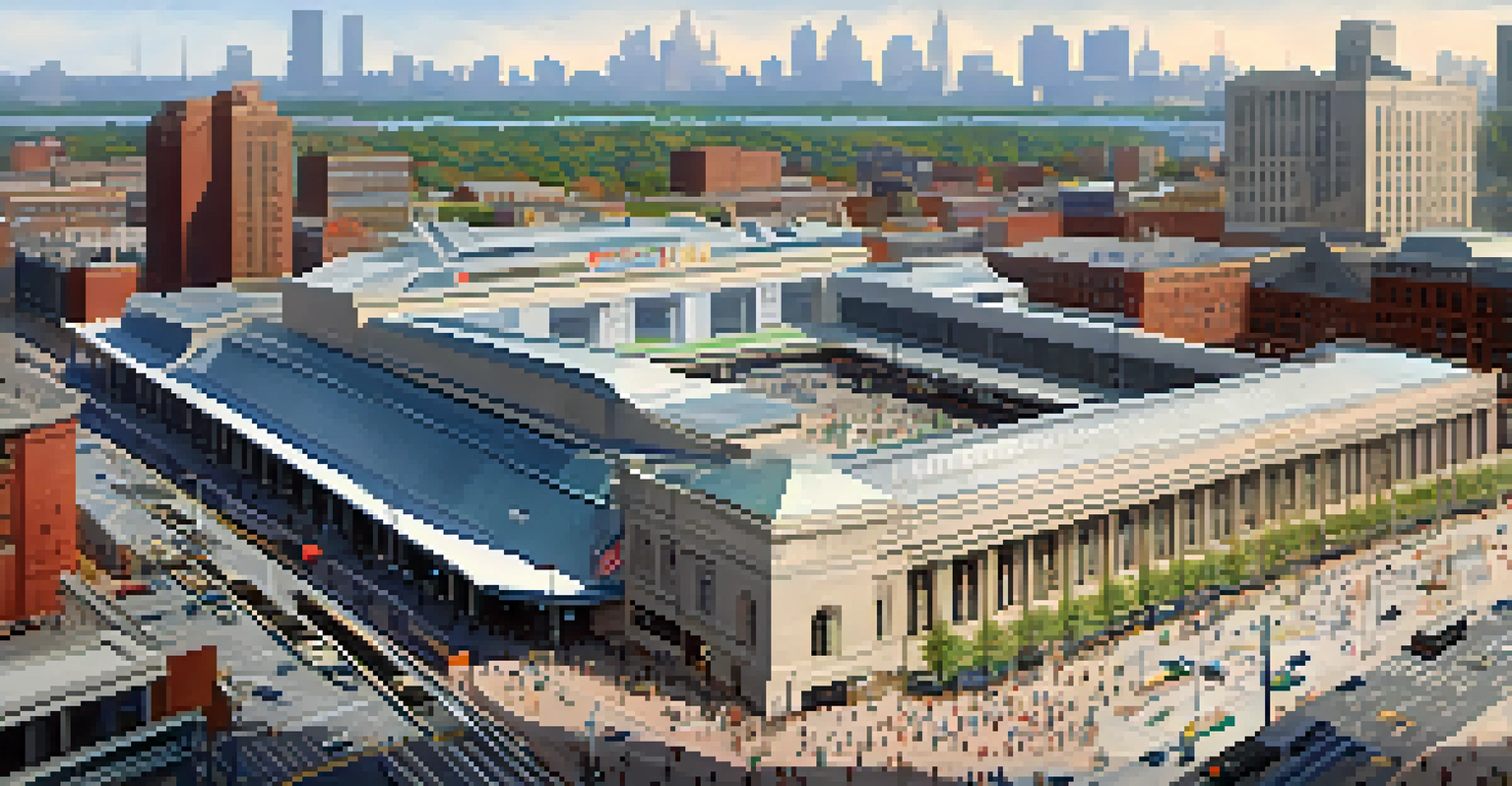Revitalization Efforts: Newark's Path to Economic Recovery

Understanding Newark's Economic Landscape
Newark, New Jersey, has faced significant economic challenges over the years, from industrial decline to population loss. Once a bustling hub, the city has undergone transformations that have impacted its economic fabric. Recognizing these hurdles is essential to understanding the revitalization efforts currently in play.
Revitalization is not just about the economy; it's about building a community that thrives together.
The city has a rich history, being a key player in the manufacturing sector during the early 20th century. However, as industries shifted and jobs moved elsewhere, Newark experienced a downturn. The need for economic recovery has become a rallying point for community leaders, businesses, and residents alike.
By examining Newark's economic landscape, we can appreciate the urgency of revitalization. This understanding serves as the foundation for the strategic initiatives that are being implemented to foster growth and stability.
Key Players in Newark's Revitalization
Revitalization efforts in Newark are not a solo endeavor; they involve a collaboration of various stakeholders. Local government, nonprofits, and private enterprises have come together to address the city's economic challenges. This coalition is crucial in identifying the needs of the community and pooling resources for effective solutions.

For instance, the Newark Alliance is a nonprofit organization that connects businesses and residents to create opportunities for economic growth. Their initiatives range from supporting local startups to enhancing workforce development programs. By fostering partnerships, they are able to leverage resources and expertise across sectors.
Revitalization through Collaboration
Newark's economic recovery involves a coalition of local government, nonprofits, and businesses working together to address community needs.
Additionally, local universities and institutions play a vital role by providing research, training, and innovation. Their involvement not only enriches the community but also equips residents with the skills needed for emerging job markets.
Investment in Infrastructure and Development
A significant aspect of Newark's revitalization is the investment in infrastructure and urban development. From transportation improvements to public spaces, these enhancements are designed to attract businesses and make the city more livable. An efficient infrastructure system is vital for economic growth, facilitating the movement of goods, services, and people.
The best way to predict the future is to create it.
Notable projects include the revitalization of Newark Penn Station and the development of the Newark Broad Street Station area. These projects not only improve accessibility but also encourage new businesses to set up shop in the area. Enhanced infrastructure can act as a magnet for investment, creating job opportunities and stimulating local economies.
Moreover, parks and recreational spaces are being developed to improve residents' quality of life. By creating inviting public spaces, Newark aims to attract visitors and foster a sense of community, which can lead to increased economic activity.
Fostering Entrepreneurship and Small Businesses
Entrepreneurship is at the heart of Newark's economic revitalization. The city has recognized the importance of supporting small businesses, which are often the backbone of the local economy. Initiatives aimed at fostering entrepreneurship include financial assistance programs, mentorship opportunities, and access to co-working spaces.
Organizations like the Newark Community Economic Development Corporation (NCEDC) provide resources and guidance for aspiring business owners. They offer workshops, training, and networking opportunities to help entrepreneurs navigate the challenges of starting and running a business. This support is crucial in building a vibrant startup culture in Newark.
Investing in Infrastructure
Significant investments in infrastructure and urban development are attracting businesses and enhancing the overall livability of Newark.
By creating an environment where small businesses can thrive, Newark is not only boosting its economy but also fostering innovation and creativity. These businesses contribute to job creation and help to retain talent within the city.
Enhancing Education and Workforce Development
Education is a cornerstone of Newark's revitalization strategy, as it directly impacts workforce development. The city has prioritized improving educational opportunities, ensuring that residents have access to quality schooling and vocational training. A well-educated workforce is essential for attracting businesses and fostering economic growth.
Programs aimed at bridging the skills gap are being implemented in collaboration with local schools and higher education institutions. These initiatives focus on equipping students with the skills needed for in-demand jobs, particularly in fields like technology and healthcare. By aligning education with industry needs, Newark is preparing its residents for successful careers.
Moreover, partnerships between businesses and educational institutions have emerged, creating internship and apprenticeship opportunities. These hands-on experiences are invaluable for students and help businesses cultivate a skilled workforce, ultimately benefiting the local economy.
Community Engagement and Inclusivity
Revitalization efforts in Newark prioritize community engagement and inclusivity, ensuring that all residents have a voice in the process. Public forums, town hall meetings, and outreach programs encourage community members to share their ideas and concerns. This participatory approach helps to build trust and fosters a sense of ownership among residents.
Inclusivity is key to Newark's revitalization strategy, as it aims to address the needs of diverse populations. Efforts are being made to ensure that economic opportunities are accessible to all, regardless of background. This includes targeted programs for minority-owned businesses and initiatives that support underserved communities.
Focus on Education and Skills
Improving educational opportunities and workforce development is crucial for equipping residents with the skills needed for in-demand jobs.
By placing community input at the forefront, Newark is creating a revitalization plan that truly reflects the needs of its residents. This collaborative spirit not only enhances the effectiveness of initiatives but also strengthens community bonds.
Measuring Progress and Future Outlook
As Newark embarks on its path to economic recovery, measuring progress is critical. Key performance indicators, such as job creation rates, business growth, and educational outcomes, help stakeholders assess the effectiveness of revitalization efforts. Continuous evaluation ensures that strategies can be adjusted and improved as needed.
Reports and surveys involving residents and businesses provide valuable feedback on the initiatives' impact. This data-driven approach allows for informed decision-making and fosters transparency. When communities see tangible results, it boosts morale and encourages further engagement.

Looking to the future, Newark aims to sustain its momentum and continue building on its successes. With a focus on innovation, collaboration, and inclusivity, the city is poised to become a model for urban revitalization, inspiring other cities facing similar challenges.